Armenia
| Author: Laxman Burdak, IFS (R) |
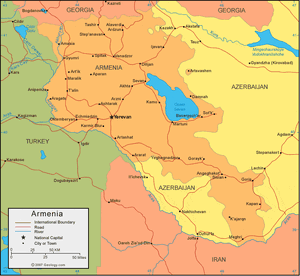

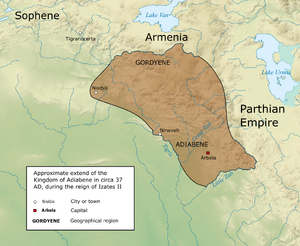
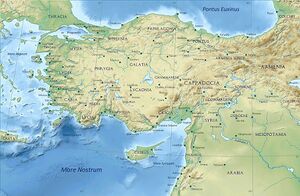
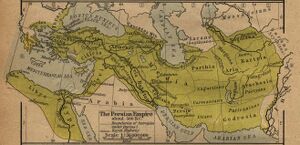

Armenia (अरमेनियां) is a mountainous country in Russia in the South Caucasus region of Eurasia. Yerevan is the capital, largest city and the financial center. It is a Country culturally and/or politcally close to Europe but not within its geographical borders (100% within geographical Asia) It was known as Ramaniyaka (रामणीयक) Dvipa during Mahabharata period.
Variants
- Aram (Anabasis by Arrian, p. 87, 107, 156, 380.)
- Armenia and Armenians (Anabasis by Arrian, p. 107, 158, 155, 156, 161, 170, 171, 273, 401, 411.)
- Armenia (Pliny.vi.39)
- Armenia (आर्मिनिया) = Ramaniyaka (रामणीयक) (AS, p.790)
- Hayk
- Hayastan
- Armina (𐎠𐎼𐎷𐎡𐎴) Behistun Inscription (515 BC)
- Armenians
- Armani (Armanum, Armi)
- Aram
- Arme
- Armi
Jat Gotras Namesake
- Hayal = Hayk = Armenia and Armenians (Anabasis by Arrian, p. 107, 158, 155, 156, 161, 170, 171, 273, 401, 411.)
- Hayal = Hayk = Armenia = Aram (Anabasis by Arrian, p. 87, 107, 156, 380.)
Mention by Pliny
Pliny[1] mentions The Parthian Empire....It is requisite in this place to trace the localities of the Medi also, and to describe in succession the features of the country as far as the Persian Sea, in order that the account which follows may be the better understood. Media8 lies crosswise to the west, and so presenting itself obliquely to Parthia, closes the entrance of both kingdoms9 into which it is divided.
It has, then, on the east, the Caspii and the Parthi; on the south, Sittacene, Susiane, and Persis; on the west, Adsiabene; and on the north, Armenia.
8 Media occupied the extreme west of the great table-land of the modern Iran. It corresponded very nearly to the modern province of Irak-Ajemi.
9 The Upper and the Lower, as already mentioned.
Location
Located at the crossroads of Western Asia and Eastern Europe, it is bordered by Turkey to the west, Georgia to the north, the de facto independent Nagorno-Karabakh Republic and Azerbaijan to the east, and Iran and the Azerbaijani exclave of Nakhchivan to the south.
Etymology
The original native Armenian name for the country was Հայք (Hayk’); however, it is currently rarely used. The contemporary name Հայաստան (Hayastan) became popular in the Middle Ages by addition of the Persian suffix -stan (place). However the origins of the name Hayastan trace back to much earlier dates and were first attested in circa 5th century in the works of Agathangelos, Faustus of Byzantium, Ghazar Parpetsi, Koryun, and Sebeos.
The name has traditionally been derived from Hayk (Հայկ), the legendary patriarch of the Armenians and a great-great-grandson of Noah, who, according to the 5th-century AD author Moses of Chorene (Movsis Khorenatsi), defeated the Babylonian king Bel in 2492 BC and established his nation in the Ararat region.[2] The further origin of the name is uncertain. It is also further postulated[3][4] that the name Hay comes from one of the two confederated, Hittite vassal states – the Ḫayaša-Azzi (1600–1200 BC).
The exonym Armenia is attested in the Old Persian Behistun Inscription (515 BC) as Armina (𐎠𐎼𐎷𐎡𐎴). The Ancient Greek terms Ἀρμενία (Armenía) and Ἀρμένιοι (Arménioi, "Armenians") are first mentioned by Hecataeus of Miletus (c. 550 BC – c. 476 BC).[5]Xenophon, a Greek general serving in some of the Persian expeditions, describes many aspects of Armenian village life and hospitality in around 401 BC.[6]
Some scholars have linked the name Armenia with the Early Bronze Age state of Armani (Armanum, Armi) or the Late Bronze Age state of Arme (Shupria).[7]These connections are inconclusive as it is not known what languages were spoken in these kingdoms. Additionally, while it is agreed that Arme was located to the immediate west of Lake Van (probably in the vicinity of Sason, and therefore in the greater Armenia region), the location of the older site of Armani is a matter of debate. Some modern researchers have placed it near modern Samsat,[8] and have suggested it was populated, at least partially, by an early Indo-European-speaking people.[9] It is possible that the name Armenia originates in Armini, Urartian for "inhabitant of Arme" or "Armean country."[10] The Arme tribe of Urartian texts may have been the Urumu, who in the 12th century BC attempted to invade Assyria from the north with their allies the Mushki and the Kaskians. The Urumu apparently settled in the vicinity of Sason, lending their name to the regions of Arme and the nearby lands of Urme and Inner Urumu.[11]
It has also been speculated that the land of Ermenen (located in or near Minni), mentioned by the Egyptian pharaoh Thutmose III in 1446 BC, could be a reference to Armenia.
According to the histories of both Moses of Chorene and Michael Chamchian, Armenia derives from the name of Aram, a lineal descendant of Hayk.[12][13] The Table of Nations lists Aram as the son of Shem, to whom the Book of Jubilees attests,
- "And for Aram there came forth the fourth portion, all the land of Mesopotamia between the Tigris and the Euphrates to the north of the Chaldees to the border of the mountains of Asshur and the land of 'Arara'."[14]
Jubilees 8:21 also apportions the Mountains of Ararat to Shem, which Jubilees 9:5 expounds to be apportioned to Aram.[15]The historian Flavius Josephus also states in his Antiquities of the Jews,
- "Aram had the Aramites, which the Greeks called Syrians;... Of the four sons of Aram, Uz founded Trachonitis and Damascus: this country lies between Palestine and Celesyria. Ul founded Armenia; and Gather the Bactrians; and Mesa the Mesaneans; it is now called Charax Spasini."[16]
रामणीयक द्वीप
रामणीयक (AS, p.790) नामक एक द्वीप का उल्लेख महाभारत, आदिपर्व 26, 8 में हुआ है- 'तदा भूरभवच्छन्ना जलोमिंभिरनेकशः, रामणीयकमागच्छन् मात्रासहभुजंगमाः।' नं. ल. डे के मत में यह वर्तमान आर्मिनिया देश है।[17]
जाट इतिहास
अरमेनियां - वह स्थान जो असुरों के महान् बल का अड्डा था, अरमेनियां कहलाता है। अरमेनियां अपभ्रंश है अरि-महान् का। अरि = शत्रु, महान् = बलवान्।[18]
आर्मीनिया (Armenia) - यह रूस का प्रान्त है जो कि कैस्पियन सागर के पश्चिम तथा तुर्की से लगता हुआ है। यह असुरों के महान् बल का अड्डा था। अरमेनियां अपभ्रंश है अरि-महान् का। अरि = शत्रु, महान् = बलवान्। तात्पर्य है अदिति के वीरपुत्र दैत्यों से जिन्होंने इस देश को आबाद किया। [19]
History
Armenia is a unitary, multi-party, democratic nation-state with an ancient cultural heritage. The Kingdom of Armenia was established in the 6th century BC, after the fall of Urartu; it became the first state in the world to adopt Christianity as its religion,[20] in the early years of the 4th century (the traditional date is 301 AD).[21]
Armenians have their own unique alphabet invented by Mesrop Mashtots in 405 AD.
A former republic of the Soviet Union, Armenia is an emerging democracy.
The native Armenian name for the country is Hayk’. The name in the Middle Ages was extended to Hayastan, by addition of the Iranian suffix -stan (place). The name has traditionally been derived from Hayk, the legendary patriarch of the Armenians and a great-great-grandson of Noah, who according to the 5th century author Moses of Chorene defeated the Babylonian king Bel in 2492 BC, and established his nation in the Ararat region.[22] According to the histories of both Moses of Chorene and Michael Chamchian, Armenia derives from the name of Aram, a lineal descendant of Hayk.[23][24]
Antiquity: Armenia lies in the highlands surrounding the biblical mountains of Ararat, upon which Noah's Ark is said to have come to rest after the flood. (Bible, Gen. 8:4). There is evidence of an early civilization in Armenia in the Bronze Age and earlier, dating to about 4000 BC. Archaeological surveys in 2010 and 2011 at the Areni-1 cave complex have resulted in the discovery of the world's earliest known leather shoe,[25] skirt,[26] and wine-producing facility.[27]
According to the story of Hayk, the legendary founder of Armenia, around 2107 BC Hayk fought against Belus, the Babylonian God of War, at Çavuştepe along the Engil river to establish the very first Armenian state. Historically, this event coincides with the destruction of Akkad by the Gutian dynasty of Sumer in 2115 BC,[28] a time when Hayk may have left with the "more than 300 members of his household" as told in the legend, and also during the beginning of when a Mesopotamian Dark Age was occurring due to the fall of the Akkadian Empire in 2154 BC which may have acted as a backdrop for the events in the legend making him leave Mesopotamia.[29]
Several Bronze Age cultures and states flourished in the area of Greater Armenia, including the Trialeti-Vanadzor culture, Hayasa-Azzi, and Mitanni (located in southwestern historical Armenia), all of which are believed to have had Indo-European populations. [30] The Nairi confederation and its successor, Urartu, successively established their sovereignty over the Armenian Highlands. Each of the aforementioned nations and confederacies participated in the ethnogenesis of the Armenians. A large cuneiform lapidary inscription found in Yerevan established that the modern capital of Armenia was founded in the summer of 782 BC by King Argishti I. Yerevan is one of the world's oldest continuously inhabited cities.[31]
During the late 6th century BC, the first geographical entity that was called Armenia by neighbouring populations was established under the Orontid Dynasty within the Achaemenid Empire, as part of the latters' territories. The kingdom became fully sovereign from the sphere of influence of the Seleucid Empire in 190 BC under King Artaxias I and begun the rule of the Artaxiad dynasty. Armenia reached its height between 95 and 66 BC under Tigranes the Great, becoming the most powerful kingdom of its time east of the Roman Republic.[32] In the next centuries, Armenia was in the Persian Empire's sphere of influence during the reign of Tiridates I, the founder of the Arsacid dynasty of Armenia, which itself was a branch of the Parthian Empire. Throughout its history, the kingdom of Armenia enjoyed both periods of independence and periods of autonomy subject to contemporary empires. Its strategic location between two continents has subjected it to invasions by many peoples, including Assyria (under Ashurbanipal, at around 669–627 BC, the boundaries of Assyria reached as far as Armenia and the Caucasus Mountains),[33] Medes, Achaemenid Empire, Greeks, Parthians, Romans, Sasanian Empire, Byzantine Empire, Arabs, Seljuk Empire, Mongols, Ottoman Empire, the successive Safavid, Afsharid, and Qajar dynasties of Iran, and the Russians.
The pagan Garni Temple, probably built in the first century, is the only "Greco-Roman colonnaded building" in the post-Soviet states[34]
Religion in ancient Armenia was historically related to a set of beliefs that, in Persia, led to the emergence of Zoroastrianism. It particularly focused on the worship of Mithra and also included a pantheon of gods such as Aramazd, Vahagn, Anahit, and Astghik. The country used the solar Armenian calendar, which consisted of 12 months.
Christianity spread into the country as early as AD 40. Tiridates III of Armenia (238–314) made Christianity the state religion in 301,[35] partly, in defiance of the Sasanian Empire, it seems,[36]becoming the first officially Christian state, ten years before the Roman Empire granted Christianity an official toleration under Galerius, and 36 years before Constantine the Great was baptised. Prior to this, during the latter part of the Parthian period, Armenia was a predominantly Zoroastrian country.[37]
After the fall of the Kingdom of Armenia in 428, most of Armenia was incorporated as a marzpanate within the Sasanian Empire.[38] Following the Battle of Avarayr in 451, Christian Armenians maintained their religion and Armenia gained autonomy.[39]
Jat History
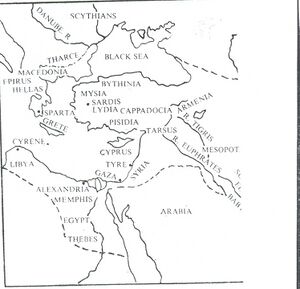
Bhim Singh Dahiya[40] writes that ....Assurbanipal died in 626 B.C. and his successors were disputing the throne. Such an opportunity was not to be lost and the second attack of Nineveh began. The Assyrian emperor burnt himself in his palace and perished with his family. In the words of prophet Nahum, "the gates of the river shall be open and the palace shall be dissolved."4 Thus in 606 B.C. Nineveh fell and so utter was its ruin that the Assyrian name was forgotten and the history of their empire soon melted into fable. Babylonia itself was roped with ties of marriage and a daughter of Huva Kshatra became the Queen of Nebu-Chad-Nezzar. Armenia and Cappadocia were included in the Manda empire. Lydia was emerging as a powerful nation in the west and it was inevitable that the two powers should collide. The war began but in 585 B.C. when there was a total eclipse of the sun, it was stopped after six years of fighting, under a peace treaty. A daughter of the Lydian emperor was married to the heir apparent of Manda, and the kingdom Urartu was annexed to Manda empire. Next year, I.e. 584 B.C. this great emperor died. Thus from a beaten nation he raised the Mandas into the most powerful an virile empire of that time. It is aptly stated that the east was Semitic
[p.131]: when he began to rule but it was Aryan when he stoped. This leader in one of the great moments in history was succeeded by Ishtuvegu, Astyages of the Greeks. He was an unworthy son of his worthy father and he deviated from the basic policy of the Mandas, i.e., to keep fit and ready for war. Luxuries of all sorts became the habit of the court. Elaborate ceremonies were prescribed for the court and the courtiers were directed to wear red and purple flying robes. Golden chains and collars were affixed and drinking vessels were made of gold. Under such influence the emperor became lethargic. He was also superstitious. He had no son and his daughter named Mandani (after the clan name) was married to a small vassal prince of Ellam, because It was forecast by the Magis that her issue will become the king of Asia and Europe. The emperor saw a vine outgrowing from Mandani which overshadowed the whole of Asia. He, therefore, feared to marry her to a noble man of his own country and thus he wanted to flout the fate. But as always happens, it was impossible to do so. The first issue of princess Mandani, was Cyrus who became the emperor, after putting in prison his maternal grandfather, Ishtuvegu through the help of General Harpagus whose son the crooked king had made into a dinner served to Harpagus himself. Three battles were fought, as per traditions preserved by the classical writers, before Ecbatana itself fell in 550 B.C. Cyrus was emperor of Persia and had inherited the empire of the Mandas which was further extended by him. But this does not mean that efforts were not made to recover the lost empire. We hear that Cyrus himself fought wars against the Jats in Balakh and the Caspian sea. At both the places he was unsuccessful. Balakh remained under the Kangs, and the small kingdom of the Massaagate ruled over by the Dahias, remained free and independent.
Migrations from Indian to north western countries
Hukum Singh Panwar (Pauria)[41] writes that We may now cite at some length from Pococke[42] who has traced Indian migrations to all corners of the world solely through linguistic similarities. This extreme reliance on phonetic similarities seems to weaken his argument, but there is ample support, from other disciplines, techniques and lines of investigation, for his claims. Further, the large body of data, he has massed together cannot be brushed away lightly. When supported by other evidence, his thesis becomes incontrovertible. According to Pococke a great number of adventurous preux chevalier tribes from India migrated to Spain, Italy, Greece, Asia Minor,Persia, Colchis, Armenia and the Caucasus region, all of which provide distinct and startling evidence of Indian colonization in great profusio. We have tried (Appendix No.6) to pinpoint the Indian names and places of the origin of the migrated tribes as well as the altered forms of their names in their new settlements in other countries. The appendix indicating all this, is by no means, exhaustive. It may not be unnecessary here to point out that in some countries the presence of Indian tribes can be construed by their names, though distorted, while, in others their identity can be traced by place names in these transformed phonemic nomenclatures. All the more significant is the fact that almost all the tribes are considered Saca-Getae (Jats) or Scythians by the learned scholar[43].(cf. Appendix No.6).
Pococke[44] believes that the major migrations took place from India as a result of internecine wars and religious persecutions in which the Buddhists had been the main victims.
To these may be added the Parasurama-Haihayas (Scythians) wars, Sagar's war against Haihayas and their allies (Sakas, Parthas,Pahlavas etc) the Dasarajna Wars, the Rama-Ravana Yudha, the Mahabharata war. Pococke lays special stress on the virulent religious strife for a long time between the Brahmins and the Buddhists for supremacy, leading to Brahmanic victory and the gigantic expulsion of the Buddhists. Pococke claims[45] that this was the most crucial event which compelled migrations and
The Jats:Their Origin, Antiquity and Migrations:End of page 307
banishment of the vanquished to the north-western countries. The Saga of the Kurus and Pandus, though ostensibly political was in reality, as Pococke[46] contends, a struggle between the Brahminical and the Buddhistic parties. Profound night clouds this portion on Indian history. What Pococke regards as clear is that the emigrants coasted along the shores of Mekran, traversed the mouth of Persian Gulf. Adhering to the sea-board of Oman, Hadramant and Yemen (the Eastern Arabia), they sailed up the Red Sea, and ascending the mighty stream - the Nile - that fertilizes a land of wonders, founded the kingdoms of Egypt, Nubia, Abyssinia[47] and Ethiopia. Fhilostratus, Julius Africanus, Eusebius and Syncellus, the Greek writers[48] assert that the Ethiopians were originally an Indian race, emigrated from the river Indus and settled in the vicinity of Egypt. This assertion cannot be dismissed lightly.
Ch.8 Description of Darius-III's Army at Arbela against Alexander
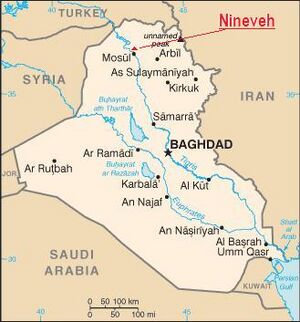
They come to the aid of Darius-III (the last king of the Achaemenid Empire of Persia) and were part of alliance in the battle of Gaugamela (331 BC) formed by Darius-III in war against Alexander the Great at Arbela, now known as Arbil, which is the capital of Kurdistan Region in northern Iraq.
Arrian[49] writes....Alexander therefore took the royal squadron of cavalry, and one squadron of the Companions, together with the Paeonian scouts, and marched with all speed; having ordered the rest of his army to follow at leisure. The Persian cavalry, seeing Alexander, advancing quickly, began to flee with all their might. Though he pressed close upon them in pursuit, most of them escaped; but a few, whose horses were fatigued by the flight, were slain, others were taken prisoners, horses and all. From these they ascertained that Darius with a large force was not far off. For the Indians who were conterminous with the Bactrians, as also the Bactrians themselves and the Sogdianians had come to the aid of Darius, all being under the command of Bessus, the viceroy of the land of Bactria. They were accompanied by the Sacians, a Scythian tribe belonging to the Scythians who dwell in Asia.[1] These were not subject to Bessus, but were in alliance with Darius. They were commanded by Mavaces, and were horse-bowmen. Barsaentes, the viceroy of Arachotia, led the Arachotians[2] and the men who were called mountaineer Indians. Satibarzanes, the viceroy of Areia, led the Areians,[3] as did Phrataphernes the Parthians, Hyrcanians, and Tapurians,[4] all of whom were horsemen. Atropates commanded the Medes, with whom were arrayed the Cadusians, Albanians, and Sacesinians.[5] The men who dwelt near the Red Sea[6] were marshalled by Ocondobates, Ariobarzanes, and Otanes. The Uxians and Susianians[7] acknowledged Oxathres son of Aboulites as their leader, and the Babylonians were commanded by Boupares. The Carians who had been deported into central Asia, and the Sitacenians[8] had been placed in the same ranks as the Babylonians. The Armenians were commanded by Orontes and Mithraustes, and the Cappadocians by Ariaoes. The Syrians from the vale between Lebanon and Anti-Lebanon (i.e. Coele-Syria) and the men of Syria which lies between the rivers[9] were led by Mazaeus. The whole army of Darius was said to contain 40,000 cavalry, 1,000,000 infantry, and 200 scythe-bearing chariots.[10] There were only a few elephants, about fifteen in number, belonging to the Indians who live this side of the Indus.[11] With these forces Darius had encamped at Gaugamela, near the river Bumodus, about 600 stades distant from the city of Arbela, in a district everywhere level;[12] for whatever ground thereabouts was unlevel and unfit for the evolutions of cavalry, had long before been levelled by the Persians, and made fit for the easy rolling of chariots and for the galloping of horses. For there were some who persuaded Darius that he had forsooth got the worst of it in the battle fought at Issus, from the narrowness of the battle-field; and this he was easily induced to believe.
1. Cf. Aelian (Varia Historia, xii. 38).
2. Arachosia comprised what is now the south-east part of Afghanistan and the north-east part of Beloochistan.
3. Aria comprised the west and north-west part of Afghanistan and the east part of Khorasan.
4. Parthia is the modern Khorasan. Hyrcania was the country south and south-east of the Caspian Sea. The Tapurians dwelt in the north of Media, on the borders of Parthia between the Caspian passes. Cf. Ammianus, xxiii. 6.
5. The Cadusians lived south-west of the Caspian, the Albanians on the west of the same sea, in the south-east part of Georgia, and the Sacesinians in the north-east of Armenia, on the river Kur.
6. "The Red Sea was the name originally given to the whole expanse of sea to the west of India as far as Africa. The name was subsequently given to the Arabian Gulf exclusively. In Hebrew it is called Yam-Suph (Sea of Sedge, or a seaweed resembling wool). The Egyptians called it the Sea of Weeds.
7. The Uxians occupied the north-west of Persis, and Susiana was the country to the north and west of Persis.
8. The Sitacenians lived in the south of Assyria. ἐτετάχατο. is the Ionic form for τεταγμἑνοι ἦσαν.
9. The Greeks called this country Mesopotamia because it lies between the rivers Euphrates and Tigris. In the Bible it is called Paddan-Aram (the plain of Aram, which is the Hebrew name of Syria). In Gen. xlviii. 7 it is called merely Paddan, the plain. In Hos. xii. 12, it is called the field of Aram, or, as our Bible has it, the country of Syria. Elsewhere in the Bible it is called Aram-naharaim, Aram of the two rivers, which the Greeks translated Mesopotamia. It is called "the Island," by Arabian geographers.
10. Curtius (iv. 35 and 45) states that Darius had 200,000 infantry, 45,000 cavalry, and 200 scythed chariots; Diodorus (xvii. 53) says, 800,000 infantry, 200,000 cavalry, and 200 scythed chariots; Justin (xi. 12) gives 400,000 foot and 100,000 horse; and Plutarch (Alex., 31) speaks of a million of men. For the chariots cf. Xenophon (Anab., i 8, 10); Livy, xxxvii. 41.
11. This is the first instance on record of the employment of elephants in battle.
12. This river is now called Ghasir, a tributary of the Great Zab. The village Gaugamela was in the district of Assyria called Aturia, about 69 miles from the city of Arbela, now called Erbil.
See also
External Links
References
- ↑ Natural History by Pliny Book VI/Chapter 29
- ↑ Razmik Panossian, The Armenians: From Kings And Priests to Merchants And Commissars, Columbia University Press (2006), ISBN 978-0-231-13926-7, p. 106.
- ↑ Rafael Ishkhanyan, "Illustrated History of Armenia," Yerevan, 1989
- ↑ Elisabeth Bauer. Armenia: Past and Present (1981), p. 49
- ↑ "Χαλύβοισι πρὸς νότον Ἀρμένιοι ὁμουρέουσι (The Armenians border on the Chalybes to the south)". Chahin, Mark (2001). The Kingdom of Armenia. London: Routledge. p. fr. 203. ISBN 978-0-7007-1452-0.
- ↑ Xenophon. Anabasis. pp. IV.v.2–9.
- ↑ Ibp Inc (1 September 2013). Armenia Country Study Guide Volume 1 Strategic Information and Developments. p. 42. ISBN 978-1438773827.
- ↑ Archi, Alfonso (2016). "Egypt or Iran in the Ebla Texts?". Orientalia. 85: 3.
- ↑ Kroonen G, Barjamovic G, Peyrot M (9 May 2018). "Linguistic supplement to Damgaard et al. 2018: Early Indo-European languages, Anatolian, Tocharian and Indo-Iranian". Zenodo: 3. doi:10.5281/zenodo.1240524.
- ↑ Armen Petrosyan. The Indo-European and Ancient Near Eastern Sources of the Armenian Epic. Journal of Indo-European Studies. Institute for the Study of Man. 2002. p. 184. [1]
- ↑ Armen Petrosyan. The Indo-European and Ancient Near Eastern Sources of the Armenian Epic. Journal of Indo-European Studies. Institute for the Study of Man. 2002. pp. 166-167. [2]
- ↑ Moses of Chorene,The History of Armenia Archived 19 April 2003 at the Wayback Machine, Book 1, Ch. 12 (in Russian)
- ↑ History of Armenia by Father Michael Chamich from B.C. 2247 to the Year of Christ 1780, or 1229 of the Armenian era, Bishop's College Press, Calcutta, 1827, p. 19: "[Aram] was the first to raise the Armenian name to any degree of renown; so that contemporary nations... called them the Aramians, or followers of Aram, a name which has been corrupted into Armenians; and the country they inhabited, by universal consent, took the name of Armenia."
- ↑ "Charles, R.H. (1913). The Book of Jubilees 9:5 from The Apocrypha and Pseudepigrapha of the Old Testament. Clarendon Press". www.pseudepigrapha.com.
- ↑ "Charles, R.H. (1913). The Book of Jubilees 9:5 from The Apocrypha and Pseudepigrapha of the Old Testament. Clarendon Press". www.pseudepigrapha.com.
- ↑ Josephus, Flavius. Antiquities of the Jews. p. Book 1, section 143
- ↑ Aitihasik Sthanavali by Vijayendra Kumar Mathur, p.790
- ↑ Jat History Dalip Singh Ahlawat/Chapter IV,p.337
- ↑ Jat History Dalip Singh Ahlawat/Chapter IV,p.411
- ↑ (Garsoïan, Nina (1997). ed. R.G. Hovannisian, ed. Armenian People from Ancient to Modern Times. Palgrave Macmillan. pp. Volume 1, p.81.).
- ↑ Grousset, René (1947). Histoire de l'Arménie (1984 ed.). Payot. p. 122.. Estimated dates vary from 284 to 314. Garsoïan (op.cit. p.82), following the research of Ananian, favours the latter.
- ↑ Razmik Panossian, The Armenians: From Kings And Priests to Merchants And Commissars, Columbia University Press (2006), ISBN 978-0-231-13926-7, p. 106.
- ↑ Moses of Chorene,The History of Armenia, Book 1, Ch. 12 (Russian)
- ↑ History of Armenia by Father Michael Chamich from B.C. 2247 to the Year of Christ 1780, or 1229 of the Armenian era, Bishop's College Press, Calcutta, 1827, page 19: "[Aram] was the first to raise the Armenian name to any degree of renown; so that contemporary nations... called them the Aramians, or followers of Aram, a name which has been corrupted into Armenians; and the country they inhabited, by universal consent, took the name of Armenia."
- ↑ world's oldest leather shoe
- ↑ 5,900-year-old women’s skirt discovered in Armenian cave
- ↑ oldest-wine-press-making
- ↑ De Mieroop, Marc Van. (2004). A History of the Ancient Near East: c. 3000-323BC. (pp.67) Malden, MA: Blackwell Publishing
- ↑ Movses Khorenatsi, History of Armenia. Ed. by G. Sargsyan. Yerevan: Hayastan, 1997, (pp. 83,286)
- ↑ 1. Greppin, John A. C.; Diakonoff, I. M. (1991). "Some Effects of the Hurro-Urartian People and Their Languages upon the Earliest Armenians". Journal of the American Oriental Society. 111 (4): 720–730. doi:10.2307/603403. JSTOR 603403.; 2. Joan Aruz, Kim Benzel, Jean M. Evans, Beyond Babylon: Art, Trade, and Diplomacy in the Second Millennium B.C. Metropolitan Museum of Art (New York, N.Y.)[3] (2008) pp. 92; 3. Kossian, Aram V. (1997), The Mushki Problem Reconsidered, archived from the original on 29 August 2019, retrieved 31 August 2019 pp. 254; 4. Peter I. Bogucki and Pam J. Crabtree Ancient Europe, 8000 B.C. to A.D. 1000: An Encyclopedia of the Barbarian World. Archived 9 January 2016 at the Wayback Machine Charles Scribner's Sons, 2004 ISBN 978-0684806686; 5. Paul Thieme, The 'Aryan' Gods of the Mitanni Treaties. JAOS 80, 1960, 301-17; 6 Petrosyan, Armen (2007). "Towards the Origins of the Armenian People: The Problem of Identification of the Proto-Armenians: A Critical Review (in English)". Journal for the Society of Armenian Studies. 16: 49–54. Archived from the original on 4 October 2020. Retrieved 30 August 2019.
- ↑ Bournoutian, George A. (2003). A concise history of the Armenian people: (from ancient times to the present) (2nd ed.). Costa Mesa, California: Mazda Publishers. ISBN 9781568591414.
- ↑ Svenska forskningsinstitutet i Istanbul (1993). Lennart Rydén; Jan Olof Rosenqvist (eds.). Aspects of Late Antiquity and Early Byzantium: Papers Read at a Colloquium Held at the Swedish Research Institute in Istanbul 31 May-5 June, 1992. Swedish Research Institute. ISBN 9789186884055. OCLC 1131566057.
- ↑ Joshua J. Mark. "Assyria". World History Encyclopedia. Archived from the original on 16 April 2021.
- ↑ Charles W. Hartley; G. Bike Yazicioğlu; Adam T. Smith, eds. (2012). The Archaeology of Power and Politics in Eurasia: Regimes and Revolutions. Cambridge University Press. p. 65. ISBN 978-1-107-01652-1. "...the unique temple-tomb at Garni, just east of Yerevan – the only Greco-Roman colonnaded building anywhere in the Soviet Union."
- ↑ Brunner, Borgna (2006). Time Almanac with Information Please 2007. New York: Time Home Entertainment. p. 685. ISBN 978-1-933405-49-0.
- ↑ Mary Boyce. Zoroastrians: Their Religious Beliefs and Practices Archived 19 September 2015 at the Wayback Machine Psychology Press, 2001 ISBN 0-415-23902-8 p. 84
- ↑ Mary Boyce. Zoroastrians: Their Religious Beliefs and Practices Archived 19 September 2015 at the Wayback Machine Psychology Press, 2001 ISBN 0-415-23902-8 p. 84
- ↑ Ohannes Geukjian (13 May 2016). Ethnicity, Nationalism and Conflict in the South Caucasus: Nagorno-Karabakh and the Legacy of Soviet Nationalities Policy. Routledge. pp. 30–. ISBN 978-1-317-14074-0.
- ↑ Razmik Panossian (27 May 2006). The Armenians: From Kings and Priests to Merchants and Commissars. Columbia University Press. pp. 48–. ISBN 978-0-231-51133-9. OCLC 1017996521.
- ↑ Jats the Ancient Rulers (A clan study)/The Mandas,p.130-131
- ↑ The Jats:Their Origin, Antiquity and Migrations/The identification of the Jats, pp.307-308
- ↑ Pococke, E; India in Greece, Indian Reprint, 1972, p. 32, 47, 134.
- ↑ Ibid., pp.38, 51ff, 63, 70, 124, 148, 159, 178, 195, 205, 229, 242, 251, 255,300.
- ↑ For further study please cf. C. Wordsworth, D.O., 'Greece, Pictorial and Descriptive; Grote, His. of Greece; Niebuh" His. of Rome; Troyer, Ramayana; Tod, Ann; Is and Antiquities of Rajasthan; Ency. Metropolitania; Smith, Muth. Lex., vol.I Homer, Odessey, Iliad; Asiatic Researches; Mure, His. of Greek Literatura, . Vol.I; Strabo's Geographia; Wilson, skt. Les.; Kruse, Hellas; Smith, Dic. of Astiq.; Hamilton E, Ind. Gaz., Vol.I; Thoronton, Geog. of Ph.; Thirliwall, His. of Greece; Thueydide, Genesis and App. No. XX in Pococke's Ind. in Greece
- ↑ Ibid., Chs VI-XV
- ↑ Ibid., p. 300. Dr. Buddha Prakash describes the Epic war as the 'Saga of the Sakas'.
- ↑ Ibid., p.43
- ↑ Ibid., p. 205.
- ↑ The Anabasis of Alexander/3a, Ch.8
--- Back to Jat Places in Armenia

